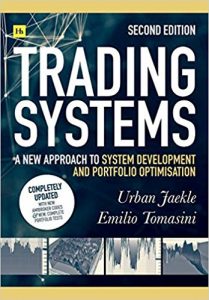Review Trading Systems: A New Approach to System Development and Portfolio Optimization
by URBAN JAEKLE & EMILIO TOMASINI
Description
Winning trades is one hundred percent hard work and an effective trading strategy combined and zero percent luck. Developing an effective trading strategy through trading with hard work and determination is now within your reach.
Trading Systems: A New Approach to System Development and Portfolio Optimisation is a reading material that best explains how traders can establish and develop new and effective winning trading systems. It gives traders insightful pieces of information that traders should know and be armed with to be able to achieve their trading goal and financial success.
About the Authors
Emilio Tomasini is a trader, professor, speaker, and writer. As a proprietary trader, he serves a number of banks and hedge funds in Europe. He is teaching corporate finance at the University of Bologna in Italy. He speaks in different conferences and trading events in Europe. He is a regular contributor to Traders’ and Active Trade magazine. He manages a business serving as an advisory firm to institutional investors.
Urban Jaekle has been trading stocks for over 25 years and futures for over 20 years. He has worked on the floor of the Chicago Mercantile Exchange (CME) and has managed money for institutional investors with algorithmic trading systems.
Table of Contents
The book contains the following topics:
Part I: A Practical Guide to Trading System Development and Evaluation
Chapter 1: What is a trading system?
An easy example of a trading system
Why you need a trading system
The science of trading systems
Chapter 2: Design, test, optimization and evaluation of a trading system
Design
Test
The forecasting power of a trading system
Evaluation of a trading system
Conclusion
Part II: Trading System Development and Evaluation of a Real Case
Chapter 3: How to develop a trading system step-by-step using the example of the British pound/US dollar pair
Introduction
The birth of a trading system
First evaluation of the trading system
Variation of the input parameters: optimization and stability diagrams
Inserting an intraday time filter
Determination of appropriate exits – risk management
Summary: Step-by-step development of a trading system
Chapter 4: Two methods for evaluating the system’s predictive power
Timescale analysis
Monte Carlo analysis
Chapter 5: The factors around your system
The market’s long/short bias
Out-of-sample deterioration
The market data bias
Optimization and over-fitting
Rule complexity explained with polynomial curve fitting
Chapter 6: Periodic re-optimisation and walk forward analysis
Short repetition
Anchored vs. rolling walk forward system
Chapter 7: Position sizing example, using the LUXOR system
Definitions
Application of different MM schemes
Monte Carlo analysis of the position sized system
Part III: Systematic Portfolio Trading
Chapter 8: Dynamic portfolio construction
Appendices: Systems and ideas
